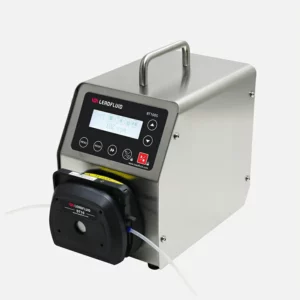Laboratory pumps play a vital role in various scientific and research settings, enabling precise and controlled fluid delivery. Among the wide range of laboratory pumps available, the dual syringe pump stands out as a versatile and efficient tool. When combined with the appropriate silicone tubing sizes, these pumps offer enhanced accuracy and flexibility for a multitude of applications. In this article, we will delve into the features and benefits of dual syringe pumps, explore the different silicone tubing sizes,laboratory pump and discuss their applications in laboratory settings.

Dual Syringe Pump: A Versatile Fluid Delivery Solution
The dual syringe pump is a specialized type of laboratory pump that utilizes two syringes to deliver fluids. This configuration allows for a wide range of applications, including continuous flow, alternating flow, and precise mixing of two different fluids. Dual syringe pumps offer exceptional accuracy, reproducibility, and control over fluid delivery rates, making them ideal for experiments requiring precise dosing or sequential delivery.
Silicone Tubing Sizes: Tailoring Fluid Delivery
Silicone tubing is commonly used in laboratory pumps due to its excellent biocompatibility, chemical resistance, and flexibility. Choosing the right silicone tubing size is crucial to ensure optimal fluid flow and prevent any potential issues. Silicone tubing sizes typically range from small diameters, such as 0.5 mm, to larger diameters, such as 8 mm, allowing for a wide range of flow rates and volumes. By selecting the appropriate tubing size, researchers can achieve the desired flow characteristics and minimize any potential backpressure or flow restrictions.
Applications in Laboratory Settings
The combination of dual syringe pumps and silicone tubing sizes finds applications across various laboratory disciplines. Some notable applications include:
- Drug Delivery and Pharmacology: Dual syringe pumps enable precise and controlled drug delivery, making them invaluable in pharmacological research, drug formulation, and therapeutic studies.
- Microfluidics: Dual syringe pumps, coupled with microfluidic devices, facilitate the precise manipulation of minute volumes of fluids, enabling advancements in fields like cell biology, biochemistry, and nanotechnology.
- Analytical Chemistry: Dual syringe pumps are commonly used in chromatography systems, allowing for accurate sample injection and eluent delivery, essential for high-performance liquid chromatography (HPLC) and gas chromatography (GC).
- Biotechnology and Bioengineering: Dual syringe pumps play a crucial role in bioprocessing, tissue engineering, and cell culture applications, providing precise control over media exchange, perfusion, and bioreactor feeding.
What is A Laboratory Pump?
Laboratory pumps are essential tools in scientific research, healthcare, and industrial settings. They play a crucial role in the precise and controlled delivery of fluids, enabling experiments, analysis, and processes that require accurate dosing, mixing, or transferring of liquids. Laboratory pumps come in various types and configurations, each designed to meet specific application requirements.
The primary purpose of a laboratory pump is to move fluids from one location to another, whether it’s transferring a liquid from a container to a reaction vessel, circulating a fluid through a system, or dispensing precise volumes for analysis. These pumps offer a wide range of flow rates, pressure capabilities, and control options to accommodate diverse experimental needs.
Application of laboratory pump
Laboratory pumps have a wide range of applications in various fields due to their ability to deliver precise and controlled fluid flows. Some common applications of laboratory pumps include:
- Chemical and Pharmaceutical Research: Laboratory pumps are extensively used in chemical and pharmaceutical research for tasks such as solvent delivery, reagent dosing, and sample preparation. They enable accurate and controlled addition of chemicals, facilitating experiments, synthesis, and analysis.
- Biotechnology and Life Sciences: Laboratory pumps play a crucial role in biotechnology and life sciences, particularly in areas like cell culture, bioprocessing, and genetic engineering. They are used for media exchange, cell feeding, and perfusion, ensuring optimal growth conditions for cells and microorganisms.
- Analytical Chemistry: Laboratory pumps are essential components of analytical instruments such as chromatography systems (HPLC, GC), spectrometers, and mass spectrometers. They deliver precise and consistent flow rates for sample introduction, eluent delivery, and mobile phase control, enabling accurate analysis and separation of compounds.
- Environmental Monitoring: Laboratory pumps are used in environmental monitoring to collect and analyze water, air, and soil samples. They facilitate the extraction and filtration of samples, allowing for the measurement of pollutants, contaminants, and other environmental parameters.
- Food and Beverage Industry: Laboratory pumps find applications in the food and beverage industry for tasks such as ingredient dosing, flavor addition, and quality control. They ensure accurate and consistent addition of ingredients, enabling product consistency and adherence to quality standards.
- Medical and Healthcare: Laboratory pumps are utilized in medical and healthcare settings for tasks such as drug delivery, infusion, and sample handling. They provide accurate and controlled administration of medications, fluids, and diagnostic reagents, ensuring patient safety and precise analysis.
Dual syringe pumps, in conjunction with carefully chosen silicone tubing sizes, offer a versatile and precise fluid delivery solution in laboratory settings. Their ability to deliver accurate and controlled fluid flows makes them indispensable in a wide range of applications, from drug delivery and microfluidics to analytical chemistry and biotechnology. By understanding the capabilities and applications of dual syringe pumps and silicone tubing sizes, researchers and scientists can optimize their experimental setups and achieve reliable and reproducible results in their laboratory work.